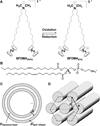Incorporation of DOPE into Lipoplexes formed from a Ferrocenyl Lipid leads to Inverse Hexagonal Nanostructures that allow Redox-Based Control of Transfection in High Serum
- PMID: 22707977
- PMCID: PMC3374640
- DOI: 10.1039/C2SM00047D
Incorporation of DOPE into Lipoplexes formed from a Ferrocenyl Lipid leads to Inverse Hexagonal Nanostructures that allow Redox-Based Control of Transfection in High Serum
Abstract
We report small angle X-ray and neutron scattering measurements that reveal that mixtures of the redox-active lipid bis(11-ferrocenylundecyl)dimethylammonium bromide (BFDMA) and dioleoylphosphatidylethanolamine (DOPE) spontaneously form lipoplexes with DNA that exhibit inverse hexagonal nanostructure (H(II) (c)). In contrast to lipoplexes of DNA and BFDMA only, which exhibit a multilamellar nanostructure (L(α) (c)) and limited ability to transfect cells in the presence of serum proteins, we measured lipoplexes of BFDMA and DOPE with the H(II) (c) nanostructure to survive incubation in serum and to expand significantly the range of media compositions (e.g., up to 80% serum) over which BFDMA can be used to transfect cells with high efficiency. Importantly, we also measured the oxidation state of the ferrocene within the BFDMA/DNA lipoplexes to have a substantial influence on the transfection efficiency of the lipoplexes in media containing serum. Specifically, whereas lipoplexes of reduced BFDMA and DOPE transfect cells with high efficiency, lipoplexes of oxidized BFDMA and DNA lead to low levels of transfection. Complementary measurements using SAXS reveal that the low transfection efficiency of the lipoplexes of oxidized BFDMA and DOPE correlates with the presence of weak Bragg peaks and thus low levels of H(II) (c) nanostructure in solution. Overall, these results provide support for our hypothesis that DOPE-induced formation of the H(II) (c) nanostructure of the BFDMA-containing lipoplexes underlies the high cell transfection efficiency measured in the presence of serum, and that the oxidation state of BFDMA within lipoplexes with DOPE substantially regulates the formation of the H(II) (c) nanostructure and thus the ability of the lipoplexes to transfect cells with DNA. More generally, the results presented in this paper suggest that lipoplexes formed from BFDMA and DOPE may offer the basis of approaches that permit active and external control of transfection of cells in the presence of high (physiologically relevant) levels of serum.
Figures






Similar articles
-
Addition of ascorbic acid to the extracellular environment activates lipoplexes of a ferrocenyl lipid and promotes cell transfection.J Control Release. 2012 Jan 30;157(2):249-59. doi: 10.1016/j.jconrel.2011.09.074. Epub 2011 Sep 22. J Control Release. 2012. PMID: 21963768 Free PMC article.
-
Chemical activation of lipoplexes formed from DNA and a redox-active, ferrocene-containing cationic lipid.Bioconjug Chem. 2008 Nov 19;19(11):2120-8. doi: 10.1021/bc8002138. Bioconjug Chem. 2008. PMID: 18831573 Free PMC article.
-
Chemical oxidation of a redox-active, ferrocene-containing cationic lipid: influence on interactions with DNA and characterization in the context of cell transfection.J Colloid Interface Sci. 2012 Dec 1;387(1):56-64. doi: 10.1016/j.jcis.2012.07.083. Epub 2012 Aug 7. J Colloid Interface Sci. 2012. PMID: 22980739 Free PMC article.
-
Influence of biological media on the structure and behavior of ferrocene-containing cationic lipid/DNA complexes used for DNA delivery.Langmuir. 2011 Jun 7;27(11):6615-21. doi: 10.1021/la200450x. Epub 2011 May 2. Langmuir. 2011. PMID: 21528933 Free PMC article.
-
Lipoplex morphologies and their influences on transfection efficiency in gene delivery.J Control Release. 2007 Nov 20;123(3):184-94. doi: 10.1016/j.jconrel.2007.08.022. Epub 2007 Aug 24. J Control Release. 2007. PMID: 17913276 Review.
Cited by
-
mRNA Lipoplexes with Cationic and Ionizable α-Amino-lipophosphonates: Membrane Fusion, Transfection, mRNA Translation and Conformation.Pharmaceutics. 2022 Mar 7;14(3):581. doi: 10.3390/pharmaceutics14030581. Pharmaceutics. 2022. PMID: 35335957 Free PMC article.
-
Influence of the Phase State of Self-Assembling Redox Mediators on their Electrochemical Activity.AIChE J. 2014 Apr 1;60(4):1381-1392. doi: 10.1002/aic.14402. AIChE J. 2014. PMID: 24882870 Free PMC article.
-
Messenger RNA Lipid-Based Nanoparticles: Optimization of Formulations in the Lab.Methods Mol Biol. 2024;2786:255-287. doi: 10.1007/978-1-0716-3770-8_12. Methods Mol Biol. 2024. PMID: 38814399
-
Small Angle X-ray and Neutron Scattering: Powerful Tools for Studying the Structure of Drug-Loaded Liposomes.Pharmaceutics. 2016 Mar 28;8(2):10. doi: 10.3390/pharmaceutics8020010. Pharmaceutics. 2016. PMID: 27043614 Free PMC article. Review.
-
Tumor priming enhances siRNA delivery and transfection in intraperitoneal tumors.J Control Release. 2014 Mar 28;178:79-85. doi: 10.1016/j.jconrel.2014.01.012. Epub 2014 Jan 23. J Control Release. 2014. PMID: 24462901 Free PMC article.
References
-
- Patnaik S, Tripathi SK, Goyal R, Arora A, Mitra K, Villaverde A, Vazquez E, Shukla Y, Kumar P, Gupta KC. Soft Matter. 2011;7:6103–6112.
-
- Ziauddin J, Sabatini DM. Nature. 2001;411:107–110. - PubMed
-
- Bailey SN, Wu RZ, Sabatini DM. Drug Discovery Today. 2002;7:S113–S118. - PubMed
-
- Delehanty JB, Shaffer KM, Lin BC. Anal. Chem. 2004;76:7323–7328. - PubMed
Grants and funding
LinkOut - more resources
Full Text Sources
Miscellaneous

